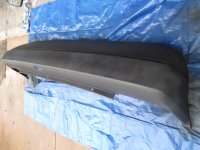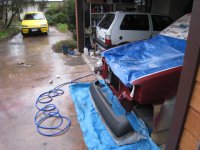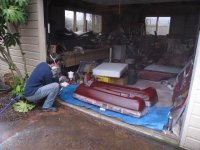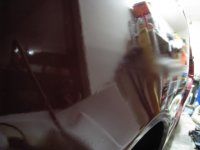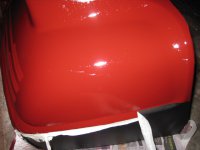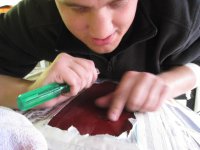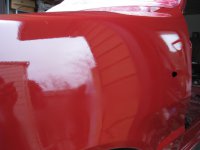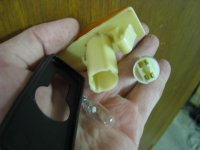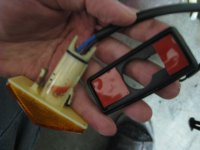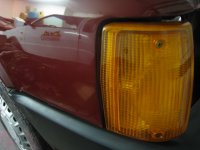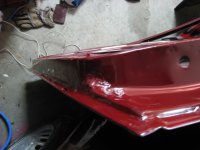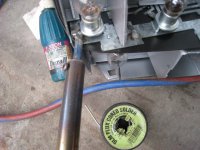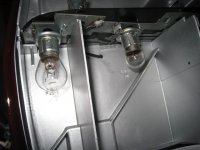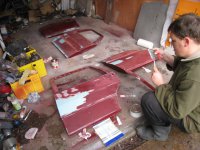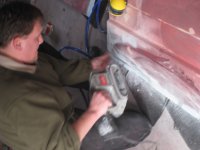This is an interesting thread and in a section I don't normally venture to, Congratulations on the progress and pleased to see you have faith in turning that car into a spectacular one. Keep It Up and Well Done.
Thanks

After a few pointed discussions about relative availabilities of TIME (I think I over-committed myself), James and I have put the project on hold for a week or two

Basically I've had other things to work on and do, and James is back at school (as a teacher, of course).
We intend to meet up in the weekend to put the interior together, and I may finish off the project next week, all being well.
Nevertheless we had made some progress last week that I didn't report on, so here's a quick summary.
FRIDAY 18th - James discovered some rust (surprise surprise!) under the roof aerial (picture) - we had a new aerial to fit. I know these things are not the most exciting but they are the sort of minor things that you must attend to before they get worse, so I included it here as an example. We sanded the rust away and applied some suitable paint.
The front wings both had orange peel (picture) - this paint texture is caused by a number of factors (e.g. paint viscosity too thick/insufficient thinners, cold temperature) but in my case I used a mixing stick to get correct paint mix and temperature was reasonable, so it was completely the result of the application. In my experience of two-pack enamel, it means that the final coat was not thick enough to 'flow out' after application. However you tread a fine line because if the coat is too thick, it runs or sags (as I've had before). So on vertical surfaces, orange peel seems quite common and you even see it on new cars (though, it tends to be a bit coarser and flatter than this - painters say 'juicier'.)
The solution was to wet-sand with 1500 grit paper and polish with my paint buffer + suitable cutting compound. I'm happy to report that it came up fine

That meant I was able to start refitting the lights and bumpers (at last!) Headlights and tail-lights had been previously restored - headlights had the glass removed and cleaned, then stuck back together with black polyurethane (I was a bit generous with the sealant), while James restored the taillights by cleaning the black plastic and spraying with nicely-reflective silver paint.
Side repeaters - sometimes they are in surprising condition (picture - I mean, it's nearly 20 years old but look at those bulb contacts) but other times, I use 3M double-sided trim tape to fasten the lens to the rubber and the rubber to the car (picture).
Front indicators - these take patience to fit properly, sometimes needing washers under the mounting studs to get the lens aligned with the front wing. Note that, to hold the lens on, I use plated steel countersunk screws rather than the 'proper' plastic-head screws - I've done this in the past as the plastic-head screws are a disaster zone when they break and can't be undone (or done-up) - also if they don't precisely align, the third-party lenses crack. Countersunk screws solve the problem by centralising themselves. They don't seem to let water in - but that would be something to watch for.
Headlights tend to be wonky unless the top mountings are fastened with screws (not all Unos seem to have the screws). It helps to have spare headlight mountings, as sometimes they are bent.
I've included a couple of sneaky preview pics to show how it's coming together. The front bumper fits pretty well - especially compared with how it was (see start of thread and the last picture added below!

)
Most of the panelbeating was achieved with nothing more than lengths of wood (to massage the dent out), plus some filling and sanding as described earlier in the thread. Also the inner wing (beside the headlight) needed a few heavy hits (a big mallet and more bits of wood) to bring the wing mounting out to where it should be, so that the indicator fits properly. Nothing was very exact - it's like cooking, you try a bit of this and a bit of that. It's important to do a number of trial fits before the final filling/sanding/painting - I even checked that the bonnet now fits properly. More than any skills or tools, it helps to have a vision of the end result in your mind, even as you stare at the original mess. The vision keeps you motivated

That's my sage advice for the day

Someone will point out that clear indicators look better.

Well, we only had one (the right side), so we decided to use two great-condition orange lenses instead. If another clear indicator lens comes to hand, we'll happily change...
-Alex
havent read it all but from what i have seen you are a very talented fiat enthusiast.



